

Taiga Video & Map GREEN. Click on a biome on the above graph for more information, informative videos, and links to scientist profiles, travel information, lesson plans and species profiles for each region.
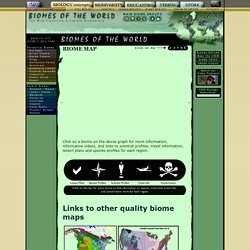
We'd like to know where you're coming from. If you've used this site for a class project or browsing for fun, add yourself to our map and communicate with other "ecogeeks" The Boreal Forest Biome: Taiga Biome. Introduction.
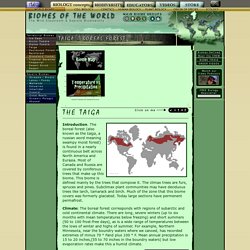
The boreal forest (also known as the taiga, a russian word meaning swampy moist forest) is found in a nearly continuous belt across North America and Eurasia. Most of Canada and Russia are covered by coniferous trees that make up this biome. Search for Your Favorite Animals. Earth Floor: Taiga Biome. Taiga The taiga biome is found in the northern hemisphere close to the polar region.
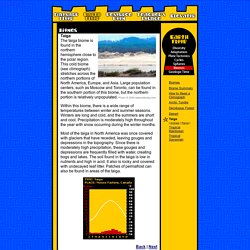
This cold biome (see climograph) stretches across the northern portions of North America, Europe, and Asia. Large population centers, such as Moscow and Toronto, can be found in the southern portion of this biome, but the northern portion is relatively unpopulated. Photo © 2000-www.arttoday.com Within this biome, there is a wide range of temperatures between winter and summer seasons. Winters are long and cold, and the summers are short and cool. Most of the taiga in North America was once covered with glaciers that have receded, leaving gouges and depressions in the topography. Back | Next. Taiga Biome. The taiga biome is the largest land biome on the Earth, extending to parts of North America and Eurasia.
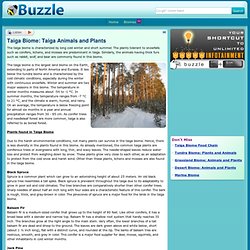
It lies below the tundra biome and is characterized by the cold climatic conditions, especially during the winter with continuous snowfalls. Winter and summer are two major seasons in this biome. The temperature in winter months measures about -54 to -1 °C. In summer months, the temperature ranges from -7 °C to 21 °C, and the climate is warm, humid, and rainy. On an average, the temperature is below freezing point for almost six months in a year and annual precipitation ranges from 30 - 85 cm.
Plants found in Taiga Biome Due to the harsh environmental conditions, not many plants can survive in the taiga biome. Black Spruce Spruce is a common plant which can grow to an astonishing height of about 25 meters. Balsam Fir Balsam fir is a medium-sized conifer that grows up to the height of 80 feet. Animals found in Taiga Biome. World Biome- Taiga. Taiga Biomes. A biome is the type of habitat in certain places, like mountain tops, deserts, and tropical forests, and is determined by the climate of the place.
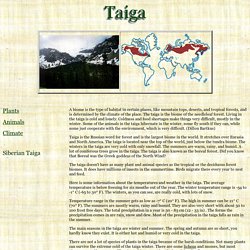
The taiga is the biome of the needleleaf forest. Living in the taiga is cold and lonely. Coldness and food shortages make things very difficult, mostly in the winter. Some of the animals in the taiga hibernate in the winter, some fly south if they can, while some just cooperate with the environment, which is very difficult. (Dillon Bartkus) Taiga is the Russian word for forest and is the largest biome in the world. The taiga doesn't have as many plant and animal species as the tropical or the deciduous forest biomes. Here is some information about the temperatures and weather in the taiga.
Temperature range in the summer gets as low as -7° C (20° F). The main seasons in the taiga are winter and summer. There are not a lot of species of plants in the taiga because of the harsh conditions. Coniferous trees are also known as evergreens. Taiga Biome. What is a Biome?
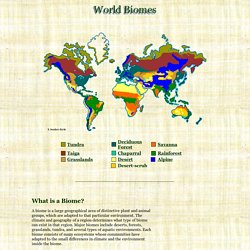
A biome is a large geographical area of distinctive plant and animal groups, which are adapted to that particular environment. The climate and geography of a region determines what type of biome can exist in that region. Major biomes include deserts, forests, grasslands, tundra, and several types of aquatic environments. Each biome consists of many ecosystems whose communities have adapted to the small differences in climate and the environment inside the biome. All living things are closely related to their environment. The earth includes a huge variety of living things, from complex plants and animals to very simple, one-celled organisms. World Biomes - Tundra.